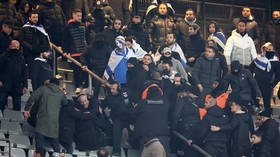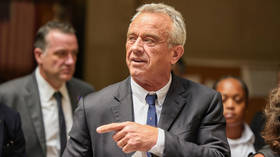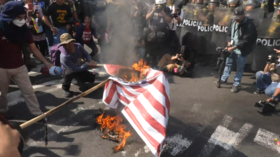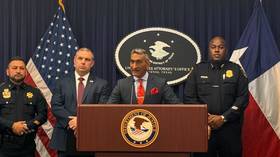Russia’s cheapest crisis ever: country still accumulating cash despite Covid-19 & oil price shock

So far, the coronavirus is proving to be the cheapest crisis Russia has ever experienced, and despite the huge economic shock the economy has received, Russia Inc is already back in profit.
Despite an oil price shock, a two-month lockdown of the entire Russian economy, a 20 percent devaluation of the ruble and an economic bailout package worth 10 percent of GDP, Russia managed to increase its hard currency reserves by $3.8 billion between January 1 and May 31.
Also on rt.com Russia to buy $1.5 billion worth of pipes to develop Arctic projects & pump gas to ChinaThe Central Bank of Russia (CBR) has managed to accumulate more than $90.2 billion in reserves over the last year, according to the latest data from the Ministry of Finance, and continued to stash extra cash away even in the midst of the current crisis, albeit at a lot slower pace.
So far the CBR has spent a total of just under $7 billion from its collective reserves to deal with the aftermath of the various shocks that have hit the economy, but that has been more than offset by the appreciation of the two thousand tons of gold the central bank holds as part of its reserves.
That is an enormous change from previous crises. Russia spent $212.8 billion of its $596 billion of total reserves to prop up the ruble and bolster the economy in the first nine months following the 2008 global financial meltdown, which is said to be less painful than the current coronacrisis.
Likewise, Russia spent $90 billion of its $454 billion of reserves in 2014 to cushion the blow during the last oil price shock, when both the value of the ruble and the price of oil halved in just a matter of months.
Also on rt.com Coronavirus crisis triggers private investment BOOM on Russian stock marketAnd neither of these two crises come anywhere close to the crises of 1991 when the Soviet Union collapsed and 1998 when Russia’s financial sector entirely melted down. The end of communism effectively bankrupted Russia, and in the aftermath of 1998 Russia had a mere $8 billion in hard currency reserves, much of which was stolen in the form of bailouts for the leading oligarch-owned banks, which promptly whisked the money away into offshore havens.
With a price tag of a mere $7 billion, so far this crisis has cost the CBR lunch money, and won’t make any noticeable dent in its cash mountain.
Golden lining
A large part of the increase in the value of Russia’s reserves is due to a revaluation of gold. The CBR had accumulated 2,299 tons of the yellow metal as of March this year, which the CBR valued at $127.6 billion as of the start of June, or $17 billion more than at the start of this year. The CBR has been actively buying gold since 2007 (and in parallel selling down its dollar denominated assets like US federal T-bills) as it tries to unhook itself from dependence on the dollar. Today, monetary gold accounts for 22 percent of Russia’s total reserves of $566.1 billion as of June 1, up from $554.4 billion as of January 1 this year.
Russia has that Midas touch.https://t.co/UEtuGG5MWl
— RT (@RT_com) May 26, 2020
Gold prices always do well in a crisis, which is part of the reason the CBR has bought so much, but since oil prices bounced back in the last week, Russia could go back to accumulating reserve cash by more traditional means. Oil prices are up since Russia signed off on the OPEC++ production cut deal that will reduce production of oil by 9.7mbpd signed on April 13 that was extended last weekend to the end of July.
Rising oil prices put Russia back in profit
Oil prices have recovered remarkably fast after the OPEC++ deal was agreed, to break above $40 to the barrel again, back into the Kremlin’s “comfort zone,” according to the Finance Ministry.
Russia Inc is back in profit with $40 oil, which is how much a barrel needs to cost for the budget to break even. In addition, at $42 per barrel Russia will start accumulating money in its reserve fund, the National Welfare Fund (NWF), as under the so-called budget rule, any oil tax revenues earned from oil prices over $42.4 has to be paid into the NWF.
Also on rt.com Russia Inc is back in business: Rebound now visible as the ruble breaks below 70 to the dollarThe NWF is there to cover any budget deficit in a crisis, and the Finance Ministry was intending to tap the fund, which held 12 trillion rubles ($174 billion) as of the start of March, to cover an anticipated deficit of 3 trillion rubles this year. The reserves fell to 9 trillion rubles in May after the Ministry of Finance used part of the funds to buy a stake in Sberbank, the biggest bank in Russia, from the CBR – a backdoor route to give the CBR a war chest of cash it could use to defend the ruble if needed – but still leaving at least three years’ worth of cash in the fund to cover a budget deficit.
Still a crisis price to pay
That is not to say this crisis is not going to be painful and that the government is not going to have to spend heavily to get Russia Inc back to work. Rosstat reported this week that the basic sectors – a good proxy for GDP – were down by 10 percent year-on-year in April and that the consumer-orientated sectors are all down by at least a third.
Last week Prime Minister Mikhail Mishustin unveiled the latest version of the National Plan for Economic Recovery (NPER), which calls for some 5 trillion rubles ($72.8 billion) of spending, or 7.8 percent of GDP. However, much of this money is simply funds that were already committed under the current budget to pay for the 12 national projects and is now going to be re-tasked to stimulate the economy or support the social sector.
Also on rt.com Most Russian companies face huge losses due to virus lockdown & have difficulty getting government aidThe bottom line is the 2 percent of GDP budget surplus will disappear and the government will run a 0.5 percent of GDP deficit, plus the Ministry of Finance intends to borrow an extra 2 trillion rubles ($29 billion) from the domestic bond market on top of the 2 trillion rubles already pencilled into the current budget, to help pay for the NPER. Again, that means the reserves will remain a last line of defence, and if Russia continues its rebound there is a good chance that the Kremlin will end this year with even more cash in reserve than it has now.
Russian rebound underway, safe haven for investors
As reported by bne IntelliNews, the economic rebound in Russia is already visible after the ruble has clawed back much of the ground it lost in the last two months against the dollar. At the same time, if there is a deficit this year the ministry also now has the option of financing it by issuing Russian Ministry of Finance ruble-denominated OFZ treasury bills, which are increasingly seen as a safe haven by international investors thanks to Russia’s rock solid finances. Indeed, over a third of the foreign investors in the OFZ are from the US, where the bonds have proven to be a popular investment with institutional investors like insurance companies and pension funds.
#Russia to drill new oil wells to be ready to go when current #OPEC+ production cut deal expires in 2022https://t.co/G8OZdTMr97pic.twitter.com/ZruCOXRiwt
— RT (@RT_com) May 28, 2020
As a sign of how popular these bonds are the yields on the OFZ have dropped 300 basis points in just four months to 5.4 percent as of the start of June after briefly spiking to 8.4 percent in March. A third of the outstanding OFZ are currently owned by foreign investors.
Doom and gloom overdone
In previous crises there has always been an army of doomsayers predicting Russia will run out of money, but not only have they been proven wrong, the opposite has always happened. In 2014 Russia did spend down its then Reserve Fund completely, but the NWF, which was originally intended to cover future pension payments, was simply re-tasked as a general economic support fund to replace the Reserve Fund.
Given the 12 trillion rubles in the NWF at the start of April, Finance Minister Anton Siluanov said there was enough in the state’s coffers to cover the budget for ten years, even if oil prices remained as low as $25 per barrel. However, within a few weeks as the scale of the coronacrisis became more apparent, Siluanov walked those statements back and said the fund would cover some three years of deficits, without the need to cut budget spending or raise taxes. Now that oil prices are back in the Kremlin’s comfort zone it could well be that the Ministry of Finance doesn't need to tap the fund at all.
If you like this story, share it with a friend!














